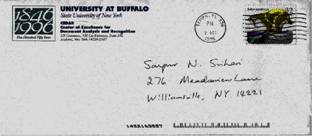
|
Feature Article |
|
Pattern Recognition at the US Postal Service:� A Decade of Achievement
By Sargur Srihari and Srirangaraj Setlur CEDAR, University at Buffalo State University of New York |


|
The early 1990s brought an upsurge of interest in document image processing. This was partly the result of scanners becoming inexpensive thanks to the prevalence of fax machines, and also due to improvements in computer speed and memory size to deal with document images that were about 9Mbyte (scanned at 300 dpi). The popularity of the field was evidenced by a new conference,� ICDAR (International Conference on Document Analysis and Recognition), which began in 1991.�
One of the most exciting applications of document image processing was in the postal area. The purpose was to recognize information in the address fields of envelopes and boxes to route this mail more efficiently and inexpensively. This required the techniques of machine- and hand-written character recognition, automatic page layout analysis, and low-level processing such as noise reduction and binarization. There were two reasons that this was a perfect application for document image recognition. One was that the fields on envelopes have a well-defined syntax, and, though there are deviations, this constrained a very difficult problem to be more manageable. The other reason was that the impact that could be made, even by small improvements, was huge, given the volume of mail.
Professor Sargur Srihari and his group at CEDAR (Center of Excellence for Document Analysis and Recognition), were early pioneers in applying document image recognition techniques to the postal application. At this time, roughly a decade after the work began, I asked for a recap of the work and current status of deployment. (L. O�Gorman, ed.)
The United States Postal Service (USPS)� is a major consumer of pattern recognition technology. Systems for sorting printed addresses for letter mail have been in existence since the mid-sixties. Systems for sorting handwritten addresses were introduced in 1996.
The task of handwritten address interpretation (HWAI) is illustrated in the letter image shown below. The goal of the interpretation is to determine the ZIP+4+2 Postnet barcode from the handwriting�the result of which is sprayed at the bottom of the envelope. This barcode is used for further sorting of the mail at each post office that it has to go through. The envelope shown below was among those in the first deployment of the HWAI system in Tampa, Florida in 1996.
Today, at the USPS, Remote Computer Readers (RCRs) automatically scan non-barcoded letter mail for address information, match the information against the Address Management System (AMS) databases�which contains addresses only and no individual names�and imprint the mail with barcodes for processing. When the RCRs are unsuccessful at finding a match, an image of the address is sent to a Remote Encoding Center (REC) where operators manually key the address information. The results are transmitted to the facility that has the mail piece, thereby keeping it in the automated mail stream. These failures are typically due to varying address formats from patron errors such as directionals in grid addresses (e.g., SW), illegible or missing address elements and technical problems that include inserts misaligned with envelope windows. The RCR-driven, USPS letter mail address recognition program is a major success story that has resulted in substantial cost savings for the USPS and more accurate and efficient mail delivery for US residents and businesses. During the past several years computer-based image recognition improvements have significantly reduced the amount of images requiring manual keying at the RECs. From 1996 to 2004, the encode rate for RCRs has increased from 35 percent to 90 percent, reducing the need for manual matching at RECs from 24 billion pieces per year to 6 billion annually.� As a result, the USPS has been able to reduce the number of RECs in the national network from a high of 55 in 1998 to only 15 today. Moving forward, the USPS hopes to reduce the amount of manual intervention even further.� The USPS will begin testing a commercial database to improve the performance of RCR devices that scan mail for address information.� Using the commercial database, the USPS hopes to improve the percentage of non-barcoded mail it can process automatically.� While the USPS in-house database of addresses doesn�t include individual name information, the commercial database does.� So, when mail compared to the AMS database fails to produce a match or produces multiple matches, the USPS plans to try to match the mail against the commercial database. For example, while mail addressed to John Doe at 123 Main St. might produce multiple matches against the AMS database (123 Main St S and 123 main St N), a comparison against the commercial database would reveal that a John Doe lives at 123 Main St. S, and a match would be made.
|


|
Feature Articles on uses of Pattern Recognition
Pattern Recognition in Traffic Engineering, Jul. �05
Pattern Recognition in Astronomy and Photonics, Apr. �05
Pattern Recognition in Origami, Jan. �05
Pattern Recognition in Defense Applications, Jan. �04 ������������ ������������ [pdf]
Pattern Recognition in Maps, Sep. �03 ������������ ������������ [pdf]
Pattern Recognition in Security and Entertainment, Jun. �03 ������������ ������������ [pdf]
Pattern Recognition in Sports, Apr. �03 ������������ ������������ [pdf]
|
